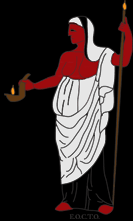
Festival of Anthesteria: Khutroi (Pot Feasts)
February 27
This is the “Festival of Flowers,” when the first shoots of blossom appear, and is one of the oldest Greek festivals, dating back to the second millennium BCE; it was also called the Older Dionysia. At this time the vines are pruned again and the second fermentation of the wine is complete; it is now ready for drinking, and so this festival complements the Oskhophoria (c. Oct. 22), which celebrates the vintage.
Since the Greeks and Romans reckoned the day from sundown, the last day of the festival begins on the night of the Day of Pitchers. This is the night of the Hieros Gamos (Sacred Marriage) of Dionysos with the Basilenna (Queen), the wife of the Archon Basileus (Priest King); he must surrender his wife to Dionysos as Theseus, his distant predecessor, surrendered Ariadne to Him. In the sacred precinct the Basilenna administers an oath of purity to the fourteen women, the Gerarai (Venerable Ones) of the Limnaion, who are appointed by her.
After daybreak the Aiora (Swing) commemorates Erigone (Early-born), who hanged herself in grief when her father, who brought viticulture to Athens, was killed by drunken men. Girls swing on swings and boys jump on sacks filled with wine. By these actions and by hanging swaying masks and puppets in trees, the children transform the memory of a sad death into a symbol of joyous new life, purify the vintage of this tragedy (swinging is a traditional means of purification by Air) and banish the underworld spirits.
A meal is prepared for the dead (and for Hermes Psuchopompos, their guide) by cooking various grains with honey in khutrai (earthen pots, after which this day is named). Everyone shares this food except the priests (for the temples are closed).
At the close of the festival the underworld spirits are banished by saying: “Thuraze Keres, ouk eni Anthesteria!” [LSJ s.v. Ker, I] (“Begone, Keres (Death Spirits), the Anthesteria are finished!”) The ritual celebration of the swinging and the banishing of the dead mark a resurrection, like that of Dionysos Himself.
